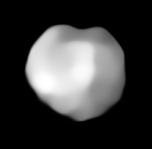 VLT-SPHERE image of Julia. The large crater Nonza, half the diameter of the asteroid, is centered on the upper left quadrant. | |
| Discovery | |
|---|---|
| Discovered by | Édouard Stephan |
| Discovery date | 6 August 1866 |
| Designations | |
| (89) Julia | |
| Pronunciation | /ˈdʒuːliə/[1] |
Named after | Julia of Corsica |
| Main belt | |
| Adjectives | Julian /ˈdʒuːliən/ |
| Orbital characteristics [2] | |
| Epoch 31 July 2016 (JD 2457600.5) | |
| Uncertainty parameter 0 | |
| Observation arc | 149.68 yr (54672 d) |
| Aphelion | 3.0202 AU (451.82 Gm) |
| Perihelion | 2.08017 AU (311.189 Gm) |
| 2.55016 AU (381.499 Gm) | |
| Eccentricity | 0.18430 |
| 4.07 yr (1487.5 d) | |
| 255.367° | |
| 0° 14m 31.272s / day | |
| Inclination | 16.128° |
| 311.563° | |
| 45.461° | |
| Physical characteristics | |
| Dimensions | c/a = 0.70±0.03[3] (89±2)×(80±1)×(62±3) km[4] |
| 140±3 km[4][3] 151±3 km[2] 148±8 km[5] | |
| Mass | (4.3±3.2)×1018 kg[3] (4.3±3.6)×1018 kg[4] (6.7±1.8)×1018 kg[5] |
Mean density | 3.0±2.2 g/cm3[3] 3.0±2.6 g/cm3[4] 4.0±1.3 g/cm3[5] |
| 11.388336±0.000001 h (0.4745 day)[4] | |
| 0.216 (calculated)[3] 0.1764±0.007[2] 0.176 [6] | |
| S | |
| 8.74 to 12.61[7] | |
| 6.60 | |
| 0.18" to 0.052" | |
89 Julia is a large main-belt asteroid that was discovered by French astronomer Édouard Stephan on 6 August 1866. This was first of his two asteroid discoveries; the other was 91 Aegina. 89 Julia is believed to be named after Saint Julia of Corsica. A stellar occultation by Julia was observed on 20 December 1985.
The spectrum of 89 Julia shows the signature of silicate rich minerals with possible indications of an abundant calcic clinopyroxene component. It is classified as an S-type asteroid. The asteroid has an estimated diameter of 151.4±3.1 km.[8] Photometry from the Oakley Observatory during 2006 produced a lightcurve that indicated a sidereal rotation period of 11.38±0.01 with an amplitude of 0.20±0.02 in magnitude.[9]
- ^ Noah Webster (1884) A Practical Dictionary of the English Language
- ^ a b c Cite error: The named reference
JPLwas invoked but never defined (see the help page). - ^ a b c d e P. Vernazza et al. (2021) VLT/SPHERE imaging survey of the largest main-belt asteroids: Final results and synthesis. Astronomy & Astrophysics 54, A56
- ^ a b c d e Vernazza et al. (August 2018) The impact crater at the origin of the Julia family detected with VLT/SPHERE?, Astronomy and Astrophysics 618, DOI: 10.1051/0004-6361/201833477
- ^ a b c Cite error: The named reference
Carry2012was invoked but never defined (see the help page). - ^ Asteroid Data Sets Archived 2009-12-17 at the Wayback Machine
- ^ Cite error: The named reference
AstDys-Juliawas invoked but never defined (see the help page). - ^ Cite error: The named reference
Birlan-2004was invoked but never defined (see the help page). - ^ Cite error: The named reference
Ditteon2007was invoked but never defined (see the help page).